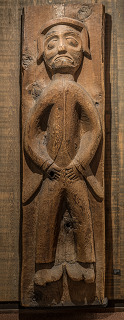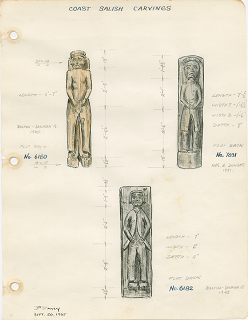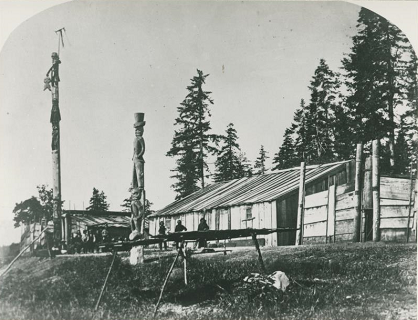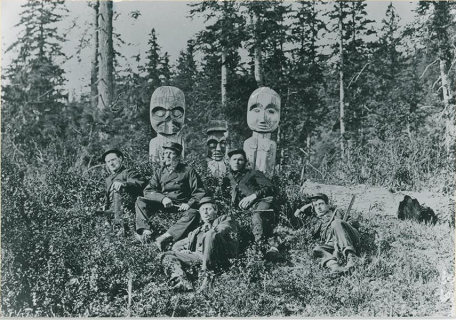House Post (RBCM 6182)

House Post

Some of the figures from K'ómoks house posts donated to the museum in 1948, drawn by John Smyly in 1965. RBCM 6182 is at the bottom.

K'ómoks village during a visit by colonial officials some time between 1866 and 1870. At one time the house post may have supported the roof of one of these houses. The figures on the poles on the left commemorate a chief, and his wife and daughters. They are dressed in store-bought cloth clothing. The structure in the foreground is a stand for drying blackberries. Frederick Dally photograph. PN 879.

Men identified as marines lounge in front of K’ómoks grave posts in the 1860s. The image suggests the visitors’ lack of understanding and respect for Indigenous traditions. Frederick Dally or Richard Maynard photograph. PN 1423.
This is one of a group of house posts and parts of house posts donated to the museum in 1948 by a resident of the city of Courtenay, near Comox. How and when they were collected is unclear but at least some of the posts were removed to Denman Island at some point. They are thought to have originated at the K'ómoks village, and are typically K'ómoks in style, but because they originally held up the beams inside a house or houses, there is no photograph or documentation of them in their original positions.
This carving, which would have been part of a larger post, portrays a European and wearing a frock coat, trousers, and hat, and standing pigeon-toed in large, heavy boots. The Indigenous people of the Northwest Coast, who traditionally did not wear tailored clothing or shoes, found the clothes and footwear of early European visitors to be odd and unnatural, as this carving shows. The figure depicted may be a naval officer on one of the many ships that frequented the eastern coast of Vancouver Island beginning in the 1790s, when Captain Vancouver from England and Captains Galiano and Valdes from Spain visited the area.
In the First Peoples gallery, this is one of two partial K'ómoks house posts (the other is RBCM 7031) installed on either side of a screen showing a film clip. The clip is from the fictionalized drama that American photographer Edward Curtis made in 1914 with George Hunt , who was from the Kwagu’ł community of Tsaxis (Fort Rupert). It shows Kwagu’ł actors in ceremonial dress. The voice-over is a reading from the journal of one of Captain Cook’s crew at the Nuu-chah-nulth (Mowachaht/Muchalaht) village of Yuquot in 1778. The film and audio together illustrate perceptions that Europeans had of Indigenous people. In contrast, this K'ómoks carving shows an Indigenous view of Europeans. Each found the other foreign and strange. Coming to a mutual understanding and a reconciliation of conflicting perspectives and histories is difficult. It takes a long time and remains an ongoing process today.
Do you have a story to share about this item? Add your voice to the community.